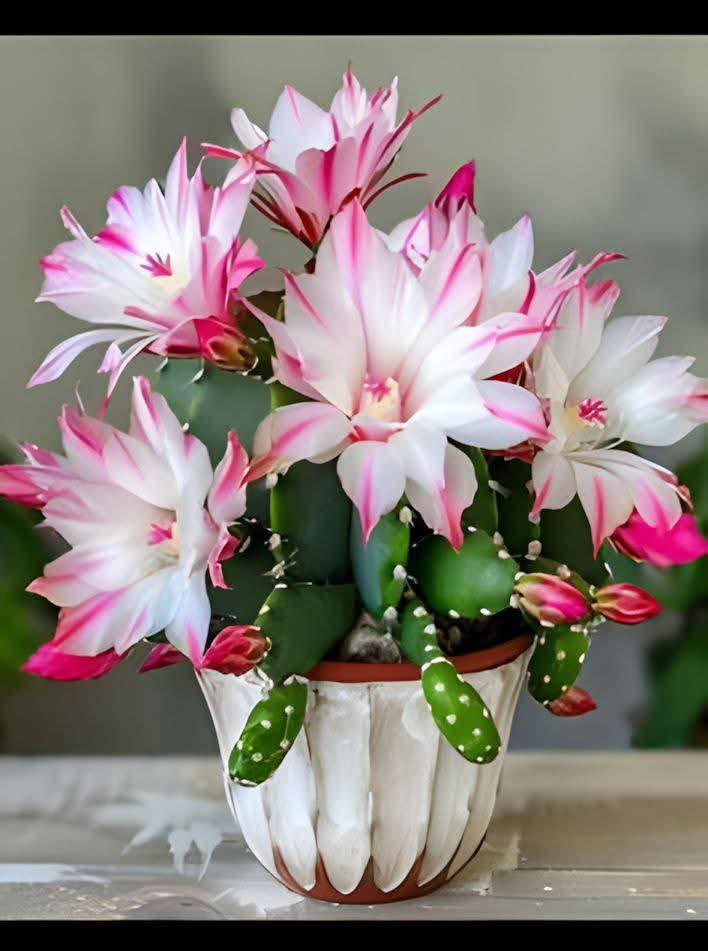Schlumbergera, commonly known as the Christmas Cactus (or Thanksgiving Cactus, depending on the blooming period), is a unique and vibrant houseplant prized for its beautiful cascading flowers that bloom during the holiday season. Unlike desert cacti, this tropical cactus thrives in humid conditions, making it a perfect indoor plant for homes and offices.
In this article, we’ll explore everything you need to know about growing, caring for, and propagating Schlumbergera to ensure your plant thrives and blooms year after year.
🌸 What Makes Schlumbergera Special?
Unlike traditional cacti, Schlumbergera is an epiphytic plant native to Brazilian rainforests, where it grows on trees and rocks in humid, shaded conditions. What sets it apart from other cacti?
✅ Beautiful, Tubular Flowers – Blooms in shades of pink, red, white, orange, and purple, appearing in late fall or winter.
✅ Flat, Segmented Stems – No sharp spines, making it a soft, pet-friendly cactus.
✅ Long Blooming Period – Can flower for several weeks, adding festive cheer to your home.
✅ Easy to Propagate – Grows quickly from cuttings, making it simple to share with friends and family.
🪴 How to Care for a Christmas Cactus
To keep your Schlumbergera healthy and blooming, follow these essential care tips:
- Light Requirements ☀️
Schlumbergera prefers bright, indirect light but cannot tolerate harsh, direct sunlight.
🌿 Best Lighting Conditions:
Place near a north- or east-facing window where it gets gentle morning light.
Too much direct sun can cause scorching and leaf discoloration.
During fall and winter, avoid artificial light at night, as this can disrupt blooming cycles.
- Watering Tips 💦
Unlike desert cacti, Schlumbergera enjoys consistent moisture but is sensitive to overwatering.
🌱 How to Water Properly:
Water when the top inch of soil is dry (about once a week in warm months, less in winter).
Use room-temperature water and allow excess to drain.
Avoid letting the plant sit in standing water, as this can cause root rot.
Reduce watering in fall and winter when the plant enters a semi-dormant phase.
- Ideal Temperature & Humidity 🌡️
Schlumbergera prefers moderate temperatures and slightly humid conditions.
🌡️ Best Temperature Ranges:
Daytime: 60-75°F (15-24°C) – Ideal for active growth.
Fall Bud Formation: 55-60°F (13-15°C) – Helps trigger blooming.
Avoid extreme temperature fluctuations from heaters, vents, or cold drafts.
💦 Humidity Needs:
Prefers moderate to high humidity (50-60%).
If indoor air is dry, mist occasionally or place a humidity tray nearby.
- Choosing the Right Soil 🌱
Since Schlumbergera is an epiphytic cactus, it needs light, well-draining soil.
✅ Best Soil Mix:
Use a cactus or succulent mix with added perlite or sand for aeration.
Alternatively, mix regular potting soil with orchid bark and pumice for better drainage.
Avoid dense or heavy soils, which trap moisture and cause root rot.
- Fertilizing for Healthy Growth 🌿
Schlumbergera benefits from regular feeding during the growing season but doesn’t require much fertilizer.
🧪 Fertilizing Schedule:
Spring to Early Fall: Feed every 2-4 weeks with a balanced liquid fertilizer (10-10-10 NPK) diluted to half strength.
Fall and Winter: Stop fertilizing once buds start forming, as extra nutrients can interfere with flowering.
Use a high-phosphorus fertilizer (e.g., 5-10-5) in late summer to encourage more blooms.
- Repotting & Container Tips 🏺
Schlumbergera likes being slightly root-bound, so repotting is only necessary every 3-4 years.
🪴 How to Repot:
Wait until spring (after blooming season).
Use a pot only 1-2 inches larger than the current one.
Ensure drainage holes to prevent excess moisture buildup.
- Encouraging Reblooming 🌺
To get your Christmas Cactus to bloom again next year, follow these simple tricks:
✅ Triggering Flower Buds:
Reduce watering and keep in a cool (55-60°F) and dark place for 6 weeks in fall.
Limit light exposure to less than 12 hours per day (similar to Poinsettias).
Once buds appear, return to normal conditions and resume watering gradually.
🌱 How to Propagate Schlumbergera
One of the best things about Schlumbergera is how easy it is to propagate.
Step-by-Step Guide:
1️⃣ Take a Cutting: Snap off a 3-5 segment stem cutting.
2️⃣ Let It Dry: Allow the cut end to air dry for 1-2 days to prevent rot.
3️⃣ Plant in Soil: Insert the cutting about ½ inch deep in a moist potting mix.
4️⃣ Provide Indirect Light: Keep in a bright, warm spot with indirect sunlight.
5️⃣ Water Sparingly: Mist lightly every few days until roots develop (in about 3-4 weeks).
🌟 Common Problems & Solutions
🟡 Yellowing Leaves
✅ Cause: Overwatering, poor drainage, or low humidity.
✔️ Fix: Reduce watering, improve drainage, and increase humidity.
🛑 No Blooms
✅ Cause: Too much light at night, warm temperatures, or improper watering.
✔️ Fix: Ensure cooler temps (55-60°F) in fall, limit light exposure, and water sparingly.
⚫ Black/Brown Spots (Fungal Disease)
✅ Cause: Overwatering or high humidity without airflow.
✔️ Fix: Improve air circulation, remove infected leaves, and use fungicide if needed.
🌿 Why You Should Grow a Schlumbergera
The Christmas Cactus is a low-maintenance yet rewarding houseplant that:
✅ Adds Festive Cheer – Perfect for winter décor with long-lasting blooms.
✅ Air-Purifying – Helps remove toxins and improve indoor air quality.
✅ Non-Toxic – Safe for pets and children (unlike some other houseplants).
✅ Easy to Propagate – Share cuttings with friends and family.
🎉 Final Thoughts: Bring Schlumbergera Into Your Home!
With its vibrant flowers, unique segmented stems, and minimal care needs, Schlumbergera is a fantastic choice for plant lovers of all levels. Whether you keep it as a holiday plant or a year-round houseplant, it’s sure to add beauty and joy to your space.
🌵 Do you have a Christmas Cactus at home? Share your care tips or blooming experiences in the comments! 🌸✨
